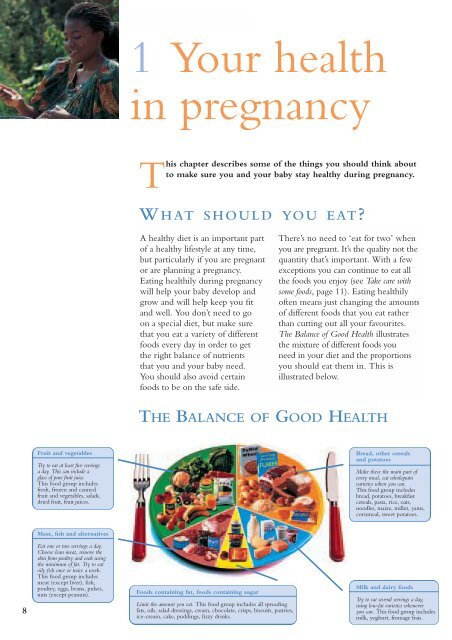here - Health Promotion Agency
here - Health Promotion Agency
here - Health Promotion Agency
You also want an ePaper? Increase the reach of your titles
YUMPU automatically turns print PDFs into web optimized ePapers that Google loves.
1 Your health<br />
in pregnancy<br />
This chapter describes some of the things you should think about<br />
to make sure you and your baby stay healthy during pregnancy.<br />
W HAT SHOULD YOU EAT?<br />
A healthy diet is an important part<br />
of a healthy lifestyle at any time,<br />
but particularly if you are pregnant<br />
or are planning a pregnancy.<br />
Eating healthily during pregnancy<br />
will help your baby develop and<br />
grow and will help keep you fit<br />
and well. You don’t need to go<br />
on a special diet, but make sure<br />
that you eat a variety of different<br />
foods every day in order to get<br />
the right balance of nutrients<br />
that you and your baby need.<br />
You should also avoid certain<br />
foods to be on the safe side.<br />
T<strong>here</strong>’s no need to ‘eat for two’ when<br />
you are pregnant. It’s the quality not the<br />
quantity that’s important. With a few<br />
exceptions you can continue to eat all<br />
the foods you enjoy (see Take care with<br />
some foods, page 11). Eating healthily<br />
often means just changing the amounts<br />
of different foods that you eat rather<br />
than cutting out all your favourites.<br />
The Balance of Good <strong>Health</strong> illustrates<br />
the mixture of different foods you<br />
need in your diet and the proportions<br />
you should eat them in. This is<br />
illustrated below.<br />
THE BALANCE OF GOOD HEALTH<br />
Fruit and vegetables<br />
Try to eat at least five servings<br />
a day. This can include a<br />
glass of pure fruit juice.<br />
This food group includes<br />
fresh, frozen and canned<br />
fruit and vegetables, salads,<br />
dried fruit, fruit juices.<br />
Bread, other cereals<br />
and potatoes<br />
Make these the main part of<br />
every meal, eat wholegrain<br />
varieties when you can.<br />
This food group includes<br />
bread, potatoes, breakfast<br />
cereals, pasta, rice, oats,<br />
noodles, maize, millet, yams,<br />
cornmeal, sweet potatoes.<br />
Meat, fish and alternatives<br />
8<br />
Eat one or two servings a day.<br />
Choose lean meat, remove the<br />
skin from poultry and cook using<br />
the minimum of fat. Try to eat<br />
oily fish once or twice a week.<br />
This food group includes<br />
meat (except liver), fish,<br />
poultry, eggs, beans, pulses,<br />
nuts (except peanuts).<br />
Foods containing fat, foods containing sugar<br />
Limit the amount you eat. This food group includes all spreading<br />
fats, oils, salad dressings, cream, chocolate, crisps, biscuits, pastries,<br />
ice-cream, cake, puddings, fizzy drinks.<br />
Milk and dairy foods<br />
Try to eat several servings a day,<br />
using low-fat varieties whenever<br />
you can. This food group includes<br />
milk, yoghurt, fromage frais.
















